
Nudity in religion deals with religious beliefs as the basis for modern attitudes and behaviors regarding nudity.

Nudity in religion deals with religious beliefs as the basis for modern attitudes and behaviors regarding nudity.

The Abrahamic religions of Judaism, Christianity, and Islam all recount the Genesis creation narrative in which Adam and Eve are unaware of their nakedness until they eat the forbidden fruit of the Tree of Knowledge of Good and Evil. After this, they feel ashamed and try to cover themselves with fig leaves. [1] Judaism does not share the Christian association of nakedness with original sin, an aspect integral to the doctrine of redemption and salvation. In Islam the garden is in Paradise, not on Earth. [lower-alpha 1] This is to show that women and men should be covered in clothing, for nudity has the stigma of shame attached to it. [lower-alpha 2] Each of these religions has its own unique understanding of what is meant to be taught with the recounting of the story of Adam and Eve.
The biblical story of Bathsheba and apocryphal story of Susanna provide no reference within the text for blame to be placed on women. [2] Regardless, some have interpreted these passages placing the blame of the men’s lusts on the women in the stories, despite the fact that the women are portrayed as victims in these stories rather than participants. [3] In contrast, the apocryphal story of Judith portrays a woman who bathes publicly to seduce and later behead the enemy general Holofernes. The contrast of the story of Judith in her deliberate attempts to seduct contrast the actions of Susanna and Bathsheba, who were victims of the male gaze. [4]
Of particular concern for both Islam and early Christians, as they extended their control over countries that had previously been part of the Byzantine or Roman empires, was the local custom of public bathing. While Christians were mainly concerned about mixed-gender bathing, which had been common, Islam also prohibited nudity for women in the company of non-Muslim women. [5] In general, the Roman bathing facilities were adapted for separation of the genders, and the bathers retaining at least a loin-cloth as in the Turkish bath of today.
In Judaism, nudity is an aspect of body modesty which is regarded as very important in most social and familial situations. Attitudes to modesty vary between the different movements within Judaism as well as between communities within each movement. In more strict (orthodox) communities, modesty is an aspect of Tzniut which generally has detailed rules of what is appropriate behaviour. Conservative and Reform Judaism generally promote modesty values but do not regard the strict Tzniut rules as binding, with each person being permitted (at least in principle) to set their own standards. With the exception of the Haredi community, Jewish communities generally tend to dress according to the standards of the society in which they find themselves.
Orthodox Jewish Law (Halakha) explicitly makes women responsible for maintaining the virtue of modesty (Tzniut) by covering their bodies, including their hair. [6] For men, nakedness was limited to exposure of the penis, but is not limited to public exposure, but in private as well. In late antiquity, Jews viewed with abhorrence the Greek and Roman practices of going naked and portraying male gods as naked. In any religious context, male nudity was of greater concern than female nudity because it was an offense against God. In everyday activity male nudity might be necessary, but is to be avoided. Female nudity was not an offense against God, but only about arousing the sexual passions of men, thus private or female only nudity was not immodest. [7]
A person who enters a ritual bath (a mikveh ) does so without clothing, and with no jewelry or even bandages.
Care needs to be taken when reading the Bible, where some references to nakedness serve as a euphemism for intimate sexual behaviour. [8] For example, in the story of Noah the hesitancy of two of Noah's sons when they have to cover their father's nakedness can be seen, averting their eyes, after Noah's youngest son "saw his father's nakedness and told his two brothers outside" what he had done to his father. [lower-alpha 3] [lower-alpha 4] Nakedness may also be a metaphor for empty-handedness, specifically in situations where a sacrifice or offering to God is expected.

There are verses in the Christian Bible that discuss the issue of nudity. [10] Before the fall of man, "Nakedness was 'very good' from the beginning, but its innocence was corrupted by the fall", a concept taught in Genesis 1:31 [11] and Genesis 2:25. [12] [10] Genesis 3:8–10, [13] Revelation 3:18 [14] and Revelation 16:15 [15] discuss that after the fall of man, "publicly exposed nakedness [became] a symbol of the shame of sin." [10] In Genesis 3:7, [16] Adam and Eve tried to cover their nakedness, though their attempt was inadequate for God and so God properly clothed humans in Genesis 3:21. [17] [10] Exodus 20:26 [18] and 28:42–43 [19] explicate that God instructed humans to cover their torso and thighs. [10]
The early Church reflected the contemporary attitudes of Judaism towards nudity. The Old Testament is not positive towards nudity. [20] In Isaiah 20, [21] Isaiah walks nude as a sign of shame.
The first recorded liturgy of baptism, written down by Saint Hippolytus of Rome in his Apostolic Tradition , required men, women and children to remove all clothing, including all foreign objects such as jewelery and hair fastenings. [22] However Laurie Guy argues that complete nudity for baptism candidates (especially women) would not be the norm. He notes that at certain times and in certain places candidates may have been totally naked at the point of baptism, but the Jewish taboo of female nakedness would have mitigated widespread practice of naked baptism. [23]
Later Christian attitudes to nudity became more restrictive, and baptisms were segregated by sex and then later were usually performed with clothed participants. Some of the Eastern Orthodox churches today maintain the early church's liturgical use of baptismal nudity, particularly for infants but also for adults.
Several saints, such as a number of the Desert Fathers as well as Basil Fool for Christ, practiced nudity as a form of ascetic poverty.[ citation needed ]
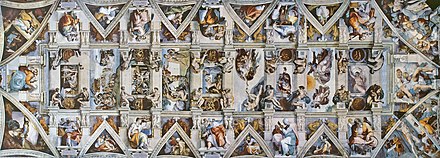
Early Christian art included depictions of nudity in baptism. When artistic endeavours revived following the Renaissance, the Catholic Church was a major sponsor of art bearing a religious theme, many of which included subjects in various states of dress and including full nudity. Painters sponsored by the Church included Raphael, Caravaggio and Michelangelo, but there were many others. Many of these paintings and statues were and continue to be displayed in churches, some of which were painted as murals, the most famous of which are at the Sistine Chapel painted by Michelangelo.[ citation needed ]
Smith (1966), in discussing logion 37 [lower-alpha 5] of the Gospel of Thomas, notes that early Christian art depicts, [25] as one would expect, Adam and Eve in Paradise naked. The only other Old Testament figures who are depicted nude are Jonah emerging from the mouth of the Great Fish, Daniel emerging from the Lion's Den, and the resurrected in Ezekiel's vision of the dry bones: [26] these Old Testament scenes containing nude figures are precisely those which were held to be types of the resurrection. Among the New Testament illustrations, apart from baptismal scenes, there are nudes only in one representation of the raising of Lazarus and one representation of the Miracle at Cana.
In light of Exodus 29:26 [27] and 28:42–43 [28] in the Bible, which teach that nakedness is inclusive of anything that exposes the torso and thighs, Methodists of the conservative holiness movement wear pants or dresses that go beyond the knees, as well as shirts that cover the underarms. [10]
In 1981, Pope John Paul II expressed the Catholic Church's attitude to the exposure of the human body in Love and Responsibility : "The human body can remain nude and uncovered and preserve intact its splendour and its beauty... Nakedness as such is not to be equated with physical shamelessness... Immodesty is present only when nakedness plays a negative role with regard to the value of the person... The human body is not in itself shameful... Shamelessness (just like shame and modesty) is a function of the interior of a person." [29]

Sects have arisen within Christianity from time to time that have viewed nudity in a more positive light. For example, to the Adamites and the Freedomites, social nudity was an integral part of their ritual.[ citation needed ] The Adamites, an early Christian sect, practiced "holy nudism", engaging in common worship in the nude. During the Middle Ages, the doctrines of this obscure sect were revived: in the Netherlands by the Brethren of the Free Spirit and the Taborites in Bohemia, and, in a grosser form, by the Beghards in Germany. Everywhere, they met with firm opposition from the mainstream Christian churches. [30]
A religious sect in Canada that immigrated from Russia, the Sons of Freedom, went so far in the 20th century (1903–1950s) as to publicly strip in mass public demonstrations to protest against government policies which were meant to assimilate them. [31]
Christian naturism contains various members associated with most denominations. Although beliefs vary, a common theme is that much of Christianity has misinterpreted the events regarding the Garden of Eden, and God was displeased with Adam and Eve for covering their bodies with fig leaves. [32] De Clercq (2011) argues that the significance of the human need for clothing by far exceeds its theological meaning.
The practice known as veiling of women in public predates Islam in Persia, Syria, and Anatolia. Islamic clothing for men covers the area from the waist to the knees. In the medieval period, Islamic norms became more patriarchal, and very concerned with the chastity of women before marriage and fidelity afterward. Women were not only veiled, but segregated from society, with no contact with men not of close kinship, the presence of whom defined the difference between public and private spaces. [33]
Islamic countries are guided by rules of modesty that forbid nudity, with variations between five schools of Islamic law. The most conservative is the Hanbali School in Saudi Arabia and Qatar, where it is widespread for women wear the niqab, the garment covering the whole body and the face with a narrow opening for the eyes. Hands are also hidden within sleeves as much as possible. The burqa, limited mainly to Afghanistan, also has a mesh screen which covers the eye opening. [34] Different rules apply to men, women, and children; and depend upon the gender and family relationship of others present. [35] The Sunni scholar Yusuf al-Qaradawi states that looking at the intimate parts of the body of another of either sex must be avoided. For women after puberty, the prohibition includes the entire body except the hands and face. However, hands and face may be shown only if they may be viewed without temptation. Men must cover themselves from the navel to the knees. [36] Shame dictates that the genitals should be covered even when a person is alone. [37] The dress of women must not only cover virtually the entire body, but cannot be either transparent or close-fitting to reveal the shape of the body. [38] When onlookers are close relations, prohibitions for women do not include hair, ears, neck, upper part of the chest, arms and legs. [39] The same exceptions are also made for men seeing women to whom they are proposing marriage. [40]
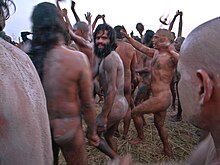
In ancient Indian cultures, there was a tradition of extreme asceticism (obviously minoritarian) that included full nudity. This tradition continued from the gymnosophists (philosophers in antiquity) to certain holy men (who may however cover themselves with ashes) in present-day Hindu devotion and in Jainism.
In the 4th century BC, Alexander the Great encountered, in India, wandering groups of naked holy men whom he dubbed the naked philosophers (Gr gymnos: naked; sophist: knowledge). The philosopher Onesicritus investigated their beliefs and lifestyle. Pyrrho the Sceptic was impressed and incorporated nudity into his philosophy. The Gymnosophists were Hindus, but Jain and Ajivika monks practiced nudity as a statement that they had given up all worldly goods. [41]
The philosophical basis of nudity arises out of the concept of 'Purushartha' (four ends of human life). 'Purushartha' (Puruṣārtha) are 'Kama' (enjoyment), 'Artha' (wealth), ‘Dharma’ (virtue) and 'Moksha' (liberation). It is ‘Purushartha’ which impels a human being towards nudity or any of its related aspect(s) either for spiritual aim or for the aim of enjoyment. Practice of ‘Dharma’ (virtue) brings good result(s) and non-practice of 'Dharma' leads to negative result(s). [42]
In the spiritual aspect of Hinduism nudity symbolises renunciation of the highest type. A nude person or deity (for example, some depictions of Kali) denotes one who is devoid of maya or attachment to the body and one who is an embodiment of infinity. [43] Trailanga Swami, the famous nude saint of India, had given an explanation for nudity in religion in the following words, "Lahiri Mahasaya is like a divine kitten, remaining wherever the Cosmic Mother has placed him. While dutifully playing the part of a worldly man, he has received that perfect Self-realization which I have sought by renouncing everything – even my loincloth!" [44]
In comparison in the material aspect nudity is considered an art. This view is supported by Sri Aurobindo in his book The Renaissance in India. He says about Hinduism in the book – "Its spiritual extremism could not prevent it from fathoming through a long era the life of the senses and its enjoyments, and there too it sought the utmost richness of sensuous detail and the depths and intensities of sensual experience. Yet it is notable that this pursuit of the most opposite extremes never resulted in disorder…" [45] Extreme hedonists and materialists like the Charvakas are very candid with regard to pursuing of sensual pleasures. They say, "Marthakamaveva purusharthau" (Riches and pleasure is the summum bonum of life). [46] There is another sloka in support of their view – "Anganalingananadijanyam sukhameva purusatha" (The sensual pleasure arising from the embrace of a woman and other objects is the highest good or end). [47] For non-hedonists pursuing kama (sensual pleasures) accompanied with dharma (virtue) can be the highest ideal or goal in life. There is nothing wrong in it. [48]
Some of the famous nude male and female yogi (male and female saints of India) of Hinduism include Lalla Yogishwari (Lalleshwari), [49] Trailanga Swami, Harihar Baba, Tota Puri. [50] Also in the biography of saint Gorakhnath we have reference to nude male and female yogis who had visited the famous Amarnath Temple during medieval period of India. [51]
Among the Hindu religious sects, only the sadhus (monks) of the Nāga sect can be seen nude. [52] They usually wear a loin-cloth around their waist, but not always; and usually remain in their Akhara or deep forest or isolation and come out in public only once every four years during Kumbh Mela. They have a very long history and are warrior monks, who usually also carry a talwar (sword), trishula (trident), bhala (javelin) or such weapons, and in medieval times have fought many wars to protect Hindu temples and shrines. [53]
In India, Digambara monks reject any form of clothing and practice nudity. Digambara (lit. 'sky clad') is one of the two main sects of Jainism. [41] However, the Shvetambara sect is "white-clad" and their holy statues wear a loin cloth. [54]

In many modern neopagan religious movements, such as Wicca, social and ritual nudity is (relatively) commonplace. In Wicca, the term skyclad refers to ritual nudity instead of social nudity. [55]
In Raëlism, nudity is not problematic. Raëlists in North America have formed GoTopless.org, which organizes demonstrations in support of topfreedom on the basis of the legal and public attitudes to the gender inequality. GoTopless sponsors an annual "Go Topless Day" protest (also known as "National GoTopless Day", "International Go-Topless Day", etc.) in advocacy for women's right to go topless on gender equality grounds. [56]

Naturism is a lifestyle of practicing non-sexual social nudity in private and in public; the word also refers to the cultural movement which advocates and defends that lifestyle. Both may alternatively be called nudism. Though the two terms are broadly interchangeable, nudism emphasizes the practice of nudity, whilst naturism highlights an attitude favoring harmony with nature and respect for the environment, into which that practice is integrated. That said, naturists come from a range of philosophical and cultural backgrounds; there is no single naturist ideology.
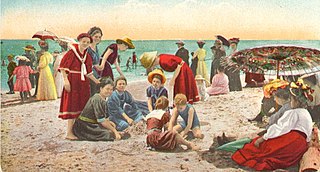
Modesty, sometimes known as demureness, is a mode of dress and deportment which intends to avoid the encouraging of sexual attraction in others. The word modesty comes from the Latin word modestus which means 'keeping within measure'.

Indecent exposure is the deliberate public exposure by a person of a portion of their body in a manner contrary to local standards of appropriate behavior. Laws and social attitudes regarding indecent exposure vary significantly in different countries. It ranges from outright prohibition of the exposure of any body parts other than the hands or face to prohibition of exposure of certain body parts, such as the genital area, buttocks or breasts.
An intimate part, personal part or private part is a place on the human body which is customarily kept covered by clothing in public venues and conventional settings, as a matter of fashion and cultural norms. In several cultures, revealing these parts is seen as a religious offense.

Toplessness refers to the state in which a woman's breasts, including her areolas and nipples, are exposed, especially in a public place or in a visual medium. The male equivalent is known as barechestedness.
The intimate parts of the human body must, according to Islam, be covered by clothing. Most of modern Islamic scholars agree that the 'awrah of a man is the area between the navel and the knees, and the 'awrah of a woman is the entire body except the face, hands and feet; exposing the 'awrah of the body is unlawful in Islam.

Pasties are patches that cover a person's nipples and areolae, typically self-adhesive or affixed with adhesive. They originated as part of burlesque shows, allowing dancers to perform fully topless without exposing the nipples in order to provide a commercial form of bare-breasted entertainment. Pasties are also, at times, used while sunbathing, worn by strippers and showgirls, or as a form of protest during women's rights events such as Go Topless Day. In some cases this is to avoid potential prosecution under indecency laws.

Depictions of nudity include all of the representations or portrayals of the unclothed human body in visual media. In a picture-making civilization, pictorial conventions continually reaffirm what is natural in human appearance, which is part of socialization. In Western societies, the contexts for depictions of nudity include information, art and pornography. Information includes both science and education. Any ambiguous image not easily fitting into one of these categories may be misinterpreted, leading to disputes. The most contentious disputes are between fine art and erotic images, which define the legal distinction of which images are permitted or prohibited.
Clothing laws vary considerably around the world. In most countries, there are no laws which prescribe what clothing is required to be worn. However, the community standards of clothing are set indirectly by way of prosecution of those who wear something that is not socially approved. Those people who wear insufficient clothing can be prosecuted in many countries under various offences termed indecent exposure, public indecency, nudity or other descriptions. Generally, these offences do not themselves define what is and what is not acceptable clothing to constitute the offence, and leave it to a judge to determine in each case.

Christian naturism is the practise of naturism or nudism by Christians.
Many Christians have followed certain dress codes during attendance at church. Customs have varied over time and among different Christian denominations. As with the Bible, the Church Fathers of Christianity taught modesty as a core principle guiding the clothing that Christians are to manufacture and wear.
The relationship between nudity and sexuality can be complicated. When people are nude, this often leads to sexual arousal, which is why indecent exposure is often considered a crime. There are also social movements to promote a greater degree of nudity, such as the topfreedom movement to promote female toplessness, as well as the movement to promote breastfeeding in public. Furthermore, some psychiatric disorders that can lead to greater nudity include exhibitionistic disorder, voyeuristic disorder, and gymnophobia.

The history of nudity involves social attitudes to nakedness of the human body in different cultures in history. The use of clothing to cover the body is one of the changes that mark the end of the Neolithic, and the beginning of civilizations. Nudity has traditionally been the social norm for both men and women in hunter-gatherer cultures in warm climates, and it is still common among many indigenous peoples. The need to cover the body is associated with human migration out of the tropics into climates where clothes were needed as protection from sun, heat, and dust in the Middle East; or from cold and rain in Europe and Asia. The first use of animal skins and cloth may have been as adornment, along with body modification, body painting, and jewelry, invented first for other purposes, such as magic, decoration, cult, or prestige. The skills used in their making were later found to be practical as well.
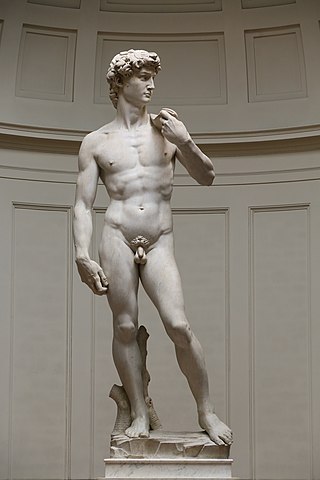
The nude, as a form of visual art that focuses on the unclothed human figure, is an enduring tradition in Western art. It was a preoccupation of Ancient Greek art, and after a semi-dormant period in the Middle Ages returned to a central position with the Renaissance. Unclothed figures often also play a part in other types of art, such as history painting, including allegorical and religious art, portraiture, or the decorative arts. From prehistory to the earliest civilizations, nude female figures were generally understood to be symbols of fertility or well-being.
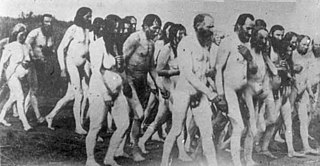
Nudity is sometimes used as a tactic during a protest to attract media and public attention to a cause, and sometimes promotion of public nudity is itself the objective of a nude protest. The practice was first documented in the 1650s with Quakers "naked as a sign" practice. Later the tactic was used by svobodniki in Canada in 1903, and photographs of their nude protests have been published. The tactic has been used by other groups later in the century, especially after the 1960s. Like public nudity in general, the cultural and legal acceptance of nudity as a tactic in protest also varies around the world. Some opponents of any public nudity claim that it is indecent, especially when it can be viewed by children; while others argue that it is a legitimate form of expression covered by the right to free speech.

Nudity is the state of being in which a human is without clothing. While estimates vary, for the first 90,000 years of pre-history, anatomically modern humans were naked, having lost their body hair and living in hospitable climates. As humans became behaviorally modern, body adornments such as jewelry, tattoos, body paint and scarification became part of non-verbal communications, indicating a person's social and individual characteristics. Indigenous peoples in warm climates used clothing for decorative, symbolic or ceremonial purposes but were often nude, having neither the need to protect the body from the elements nor any conception of nakedness being shameful. In many societies, both ancient and contemporary, children might be naked until the beginning of puberty. Women may not cover their breasts, being associated with nursing babies more than with sexuality.
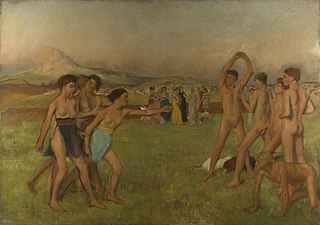
This timeline of social nudity shows the varying degrees of acceptance given to the naked human body by diverse cultures throughout history. The events listed here demonstrate how various societies have shifted between strict and lax clothing standards, how nudity has played a part in social movements and protest, and how the nude human body is accepted in the public sphere.

Naturism refers to a lifestyle of practising non-sexual social nudity in private and in public, and to the cultural movement which advocates and defends that lifestyle. Both are also known as "nudism". Naturist organisations have existed in New Zealand since the 1930s. Although not a daily feature of public life, social nudity is practised in a variety of other contexts in New Zealand culture.

Nakedness and colonialism is about the role of the unclothed bodies of Indigenous peoples in the history of contact with Western cultures and the emergence of concepts of race. In all human societies, bodily adornments of many kinds are part of nonverbal communications, indicating social status, wealth, and individuality. In climates which do not require clothing, Indigenous adornments are more often body paint, modifications such as tattoos and scarification, and jewelry, but serve the same social functions as clothing.

Nudity in India has a multifaceted history, deeply rooted in the nation's religious, cultural, and social practices. While public nudity is generally frowned upon in modern urban areas, specific religious and traditional contexts have embraced forms of nudity as symbols of purity, renunciation, or spirituality. It is worth noting that the depiction of nudity in Indian art doesn't support the claim that public nudity was acceptable/normal across all castes and regions in India. By contemporary standards, the unclothed female upper body is considered semi-nude or a sign of obscene nudity, however, historically some regions and classes/castes of modern-day India, have traditionally had this kind of public nudity/semi-nudity as the norm.
{{cite journal}}: CS1 maint: DOI inactive as of January 2024 (link){{cite book}}: CS1 maint: location missing publisher (link)